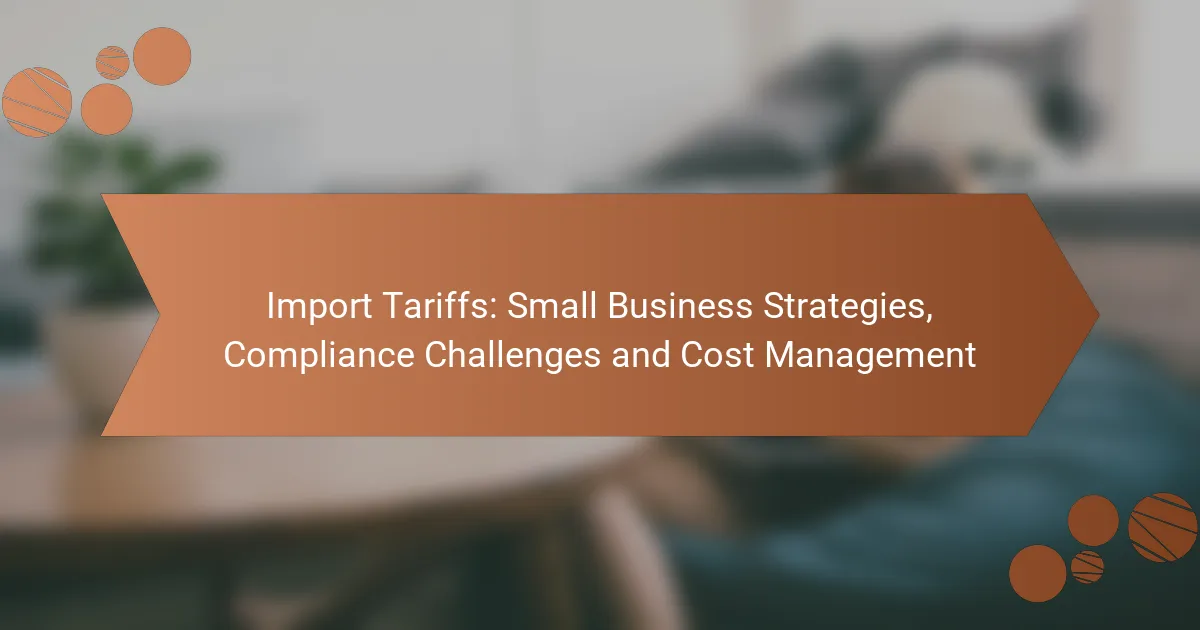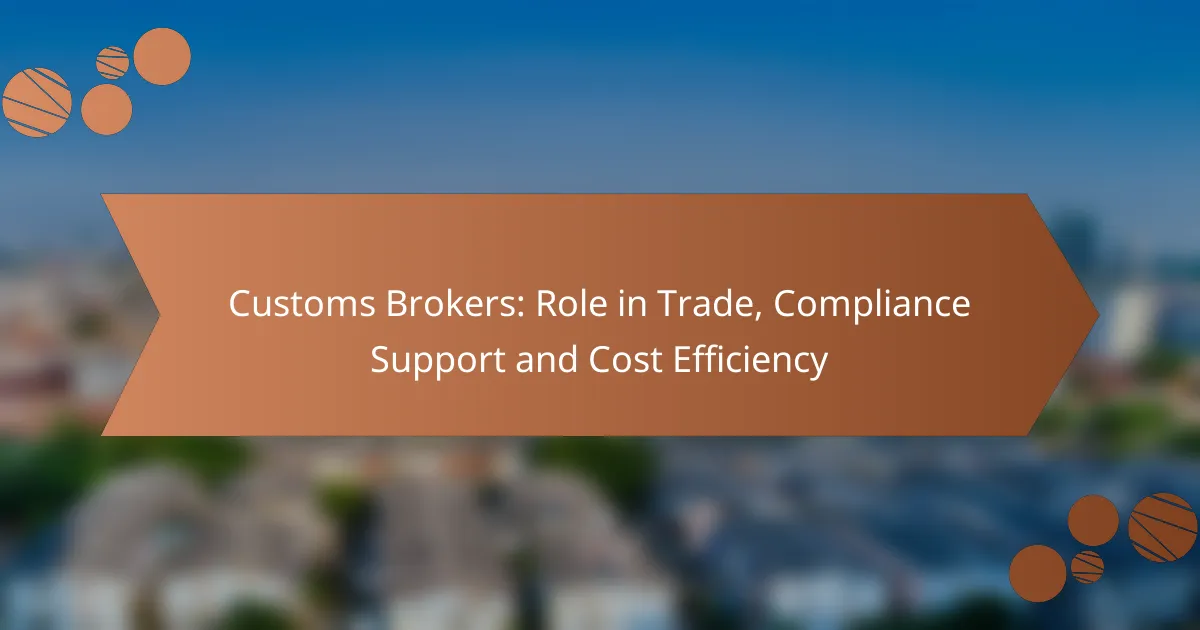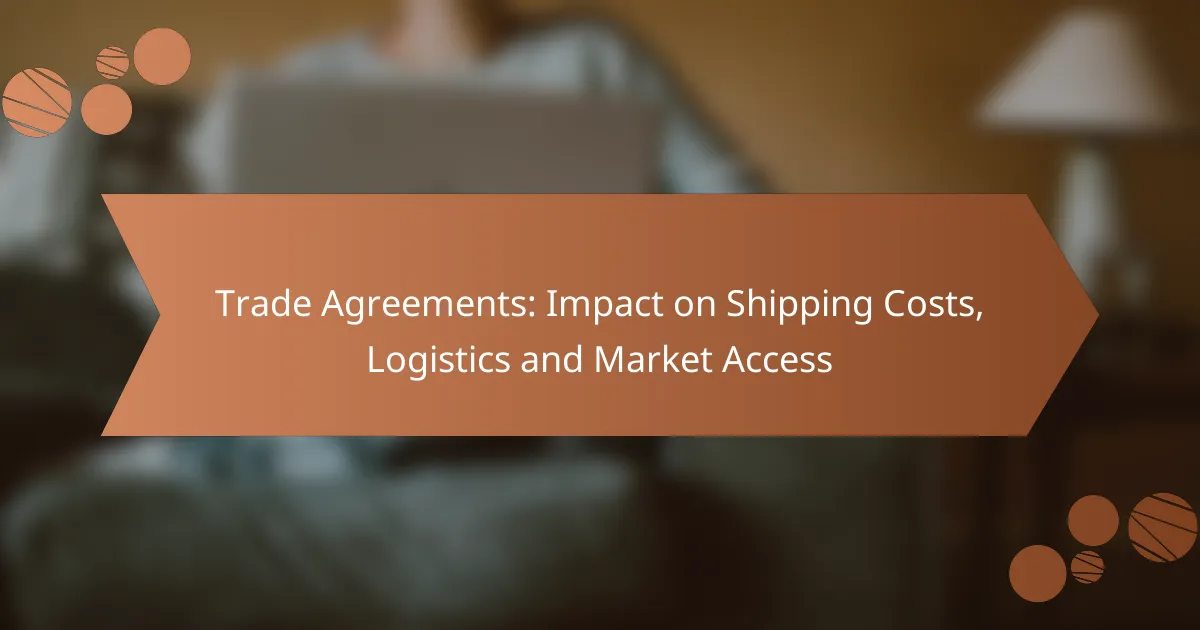Import tariffs present both challenges and opportunities for small businesses, requiring strategic approaches to minimize costs and ensure compliance. By leveraging free trade agreements, implementing tariff engineering, and utilizing technology for regulatory adherence, businesses can navigate the complexities of import tariffs effectively. Understanding relevant laws and maintaining accurate documentation are essential for avoiding penalties and managing expenses associated with importing goods.
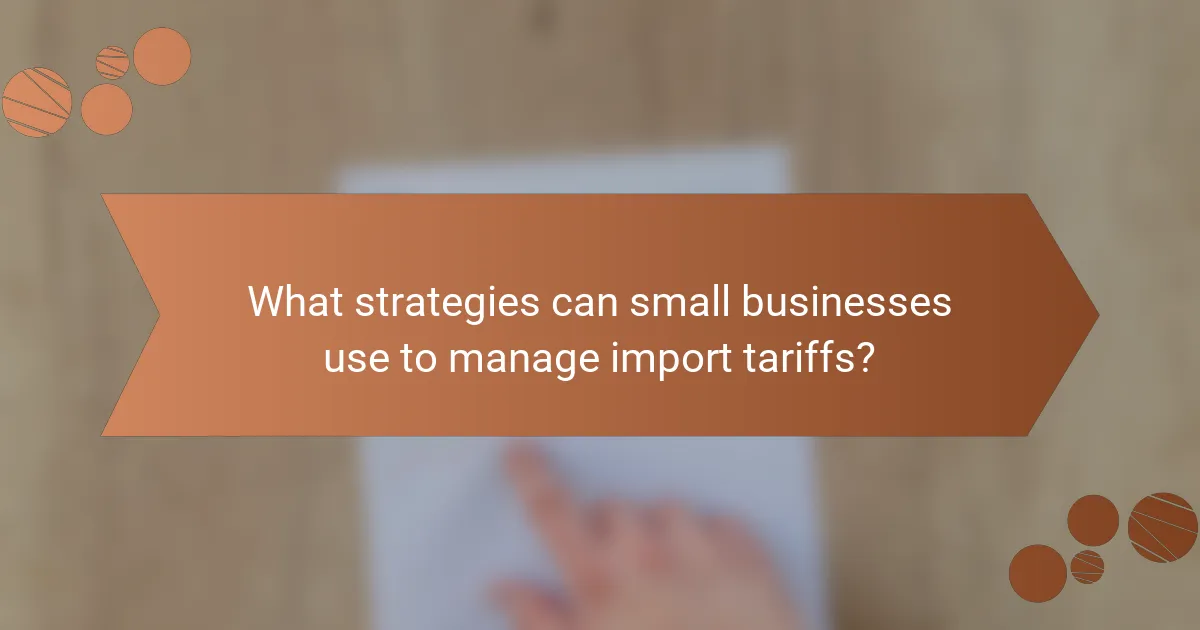
What strategies can small businesses use to manage import tariffs?
Small businesses can effectively manage import tariffs through various strategies that minimize costs and ensure compliance. Key approaches include leveraging free trade agreements, implementing tariff engineering, utilizing duty drawback programs, exploring alternative sourcing options, and adopting technology for compliance.
Utilizing Free Trade Agreements
Free trade agreements (FTAs) can significantly reduce or eliminate tariffs on imported goods. Small businesses should identify applicable FTAs between their country and the exporting nation to take advantage of lower duties.
To benefit from FTAs, businesses must ensure their products meet the specific rules of origin requirements. This might involve adjusting sourcing practices or documentation to prove compliance.
Implementing Tariff Engineering
Tariff engineering involves modifying products or their classifications to qualify for lower tariff rates. Small businesses can analyze their product specifications to determine if slight changes can lead to reduced tariffs.
For example, altering the materials used in a product or changing its design may allow it to fall under a different tariff category with lower rates. However, businesses should consult with customs experts to navigate this process effectively.
Leveraging Duty Drawback Programs
Duty drawback programs allow businesses to reclaim duties paid on imported goods that are subsequently exported or destroyed. Small businesses can benefit from these programs by keeping detailed records of imports and exports.
To maximize refunds, businesses should familiarize themselves with the application process and eligibility criteria, which can vary by country. This strategy can help recover a portion of costs associated with tariffs.
Exploring Alternative Sourcing Options
Finding alternative suppliers or sourcing from countries with lower or no tariffs can be a practical strategy for managing import costs. Small businesses should evaluate their supply chains to identify potential alternatives that align with their budget and quality standards.
Additionally, diversifying suppliers can mitigate risks associated with tariff fluctuations and trade disputes. Businesses should consider the total landed cost, including shipping and duties, when making sourcing decisions.
Adopting Technology for Compliance
Investing in technology can streamline compliance with import tariff regulations and reduce the risk of errors. Small businesses can utilize software solutions that automate tariff classification, documentation, and reporting processes.
Implementing such technology not only enhances accuracy but also saves time and resources. Regular training for staff on compliance software is essential to ensure effective use and adherence to changing regulations.
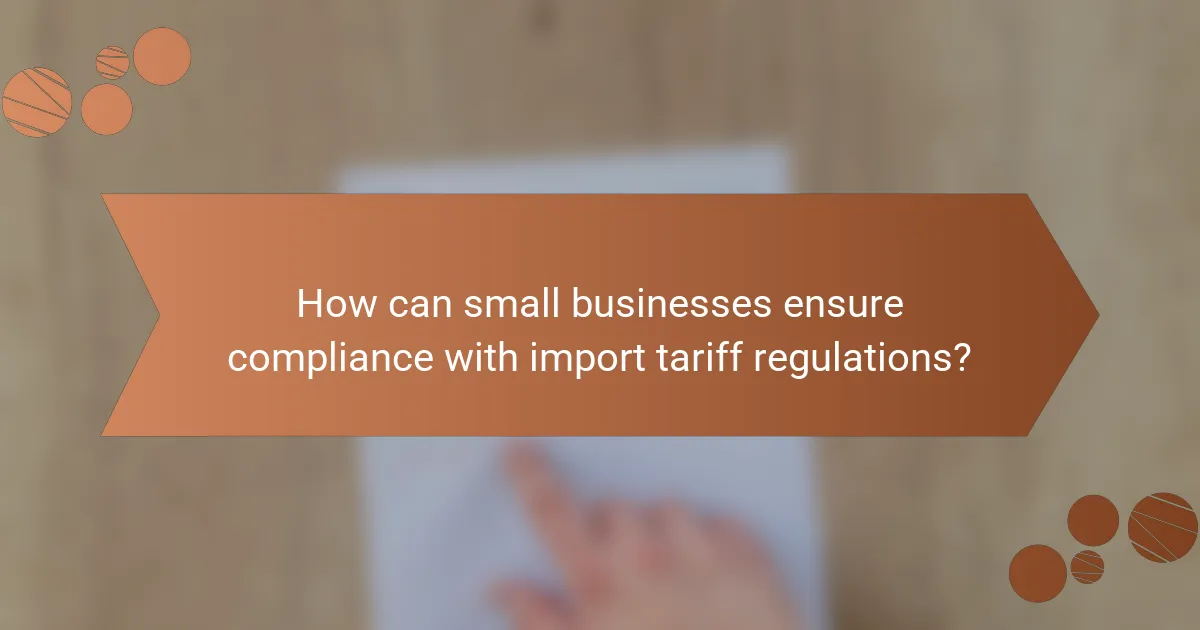
How can small businesses ensure compliance with import tariff regulations?
Small businesses can ensure compliance with import tariff regulations by understanding the relevant laws, maintaining accurate documentation, and seeking professional assistance when needed. Staying informed about changes in tariffs and regulations is crucial for avoiding penalties and managing costs effectively.
Understanding Harmonized Tariff Schedule
The Harmonized Tariff Schedule (HTS) is a standardized system used globally to classify traded products and determine applicable tariffs. Small businesses must familiarize themselves with the HTS codes relevant to their products to ensure they are paying the correct duties. Misclassification can lead to significant fines and increased costs.
To effectively use the HTS, businesses should regularly review the schedule and consult resources such as the U.S. International Trade Commission or equivalent authorities in their country. This helps in understanding any changes that may affect their imports.
Maintaining Accurate Documentation
Accurate documentation is essential for compliance with import tariff regulations. Small businesses should keep detailed records of invoices, shipping documents, and customs declarations. This documentation is critical during audits and can help resolve disputes with customs authorities.
Establishing a systematic approach to documentation can streamline the process. Consider using digital tools to track and store documents, ensuring they are easily accessible when needed.
Engaging Customs Brokers
Customs brokers are professionals who help businesses navigate the complexities of import regulations and tariffs. Engaging a customs broker can save time and reduce the risk of errors in tariff classification and documentation. They can provide valuable insights into compliance requirements and help with the submission of necessary paperwork.
When selecting a customs broker, look for one with experience in your industry and a good reputation. This can lead to better compliance and potentially lower costs associated with tariffs.
Regular Training for Staff
Regular training for staff involved in import processes is vital for maintaining compliance with tariff regulations. Employees should be educated on the latest regulations, documentation requirements, and the importance of accurate tariff classification. This reduces the likelihood of mistakes that could lead to penalties.
Consider implementing training sessions or workshops at least annually, or whenever significant changes in regulations occur. This investment in staff knowledge can enhance overall compliance and efficiency in handling imports.
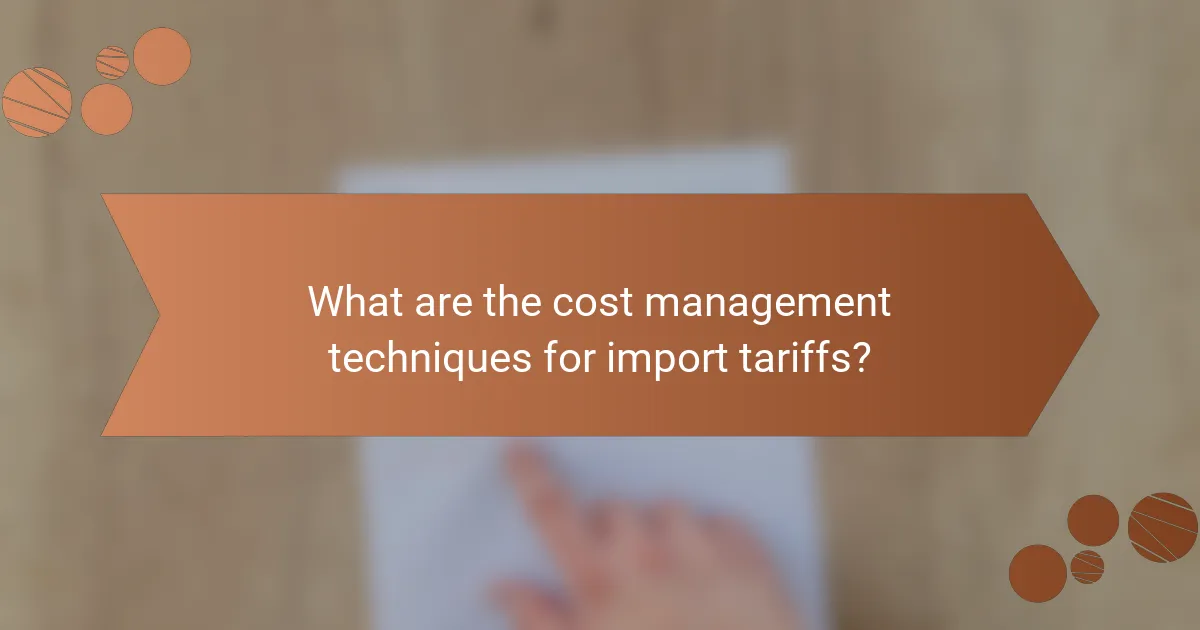
What are the cost management techniques for import tariffs?
Cost management techniques for import tariffs involve strategies that help businesses minimize expenses associated with importing goods. These techniques focus on understanding total landed costs, negotiating favorable terms with suppliers, classifying tariffs correctly, and managing inventory effectively.
Calculating Total Landed Cost
Calculating total landed cost (TLC) is essential for understanding the full expense of imported goods. TLC includes the purchase price, shipping fees, insurance, customs duties, and any additional costs incurred until the goods reach their final destination.
To accurately calculate TLC, businesses should gather all relevant invoices and shipping documents. A simple formula to follow is: TLC = Purchase Price + Shipping + Insurance + Duties + Other Fees. This comprehensive view helps identify areas where costs can be reduced.
Negotiating with Suppliers
Negotiating with suppliers can significantly impact the overall cost of imported goods. Businesses should aim to secure better pricing, payment terms, and shipping arrangements to lower their import expenses.
Consider leveraging volume discounts or long-term contracts to enhance negotiating power. Establishing a strong relationship with suppliers can also lead to more favorable terms and improved service, ultimately reducing costs over time.
Utilizing Tariff Classification Strategies
Utilizing tariff classification strategies involves correctly categorizing products to take advantage of lower duty rates. Each product falls under specific tariff codes that determine the applicable duties and taxes.
Businesses should regularly review their product classifications and consult with customs experts to ensure compliance and optimize tariff rates. Misclassification can lead to overpayment or penalties, so accuracy is crucial.
Implementing Inventory Management Practices
Implementing effective inventory management practices can help manage costs related to import tariffs. Keeping track of inventory levels and turnover rates allows businesses to make informed purchasing decisions and avoid excess stock.
Utilizing just-in-time inventory systems can minimize holding costs and reduce the impact of tariffs on cash flow. Regularly analyzing inventory data can also highlight trends that inform future import strategies and cost management efforts.

What are the common challenges small businesses face with import tariffs?
Small businesses often encounter several challenges when dealing with import tariffs, including navigating complex regulations, managing fluctuating rates, and adjusting pricing strategies. These issues can significantly impact their operational costs and competitiveness in the market.
Complexity of Tariff Regulations
The complexity of tariff regulations can be daunting for small businesses. Each country has its own set of rules, classifications, and compliance requirements that must be understood and adhered to. Misclassifying goods or failing to comply with documentation requirements can lead to penalties or increased costs.
To navigate these complexities, small businesses should consider consulting with trade experts or utilizing software that simplifies tariff classification and compliance. Regular training for staff involved in import processes can also help mitigate risks associated with regulatory misunderstandings.
Fluctuating Tariff Rates
Fluctuating tariff rates can create unpredictability in import costs for small businesses. Rates may change due to trade agreements, political shifts, or economic conditions, making it challenging to budget effectively. Businesses may find themselves facing sudden increases in costs that affect their bottom line.
To manage this risk, small businesses should stay informed about potential changes in tariff policies and consider strategies such as hedging or negotiating long-term contracts with suppliers. Keeping a close eye on market trends can also help businesses anticipate and adapt to rate fluctuations.
Impact on Pricing Strategies
Import tariffs directly affect pricing strategies for small businesses. Increased costs from tariffs may necessitate raising prices, which can impact sales and customer retention. Finding the right balance between maintaining competitive pricing and covering increased costs is crucial.
Small businesses should conduct regular cost analyses to understand how tariffs influence their pricing models. Implementing tiered pricing or offering discounts on bulk purchases can help mitigate the impact of tariffs while still attracting customers. Additionally, communicating transparently with customers about price changes can foster trust and understanding.
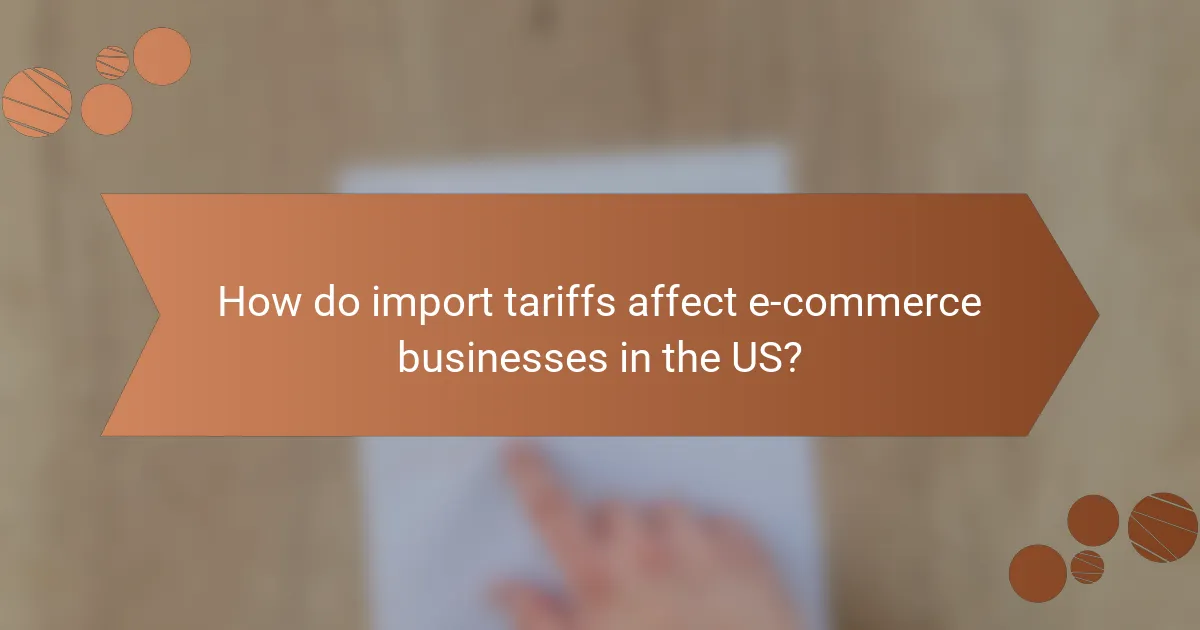
How do import tariffs affect e-commerce businesses in the US?
Import tariffs significantly impact e-commerce businesses in the US by increasing the cost of goods imported from other countries. These tariffs can lead to higher prices for consumers, reduced profit margins for businesses, and potential shifts in sourcing strategies.
Increased Product Costs
Import tariffs directly contribute to increased product costs for e-commerce businesses. When tariffs are applied, the additional expenses are often passed on to consumers, resulting in higher retail prices. Businesses must consider how these costs affect their pricing strategies and overall competitiveness in the market.
For example, if a business imports electronics worth $100 and faces a 25% tariff, the total cost rises to $125. This increase can compel businesses to either absorb the costs, reduce their profit margins, or raise prices, which may deter customers.
To manage these increased costs, e-commerce businesses should evaluate their supply chains and consider alternative sourcing options. Exploring domestic suppliers or negotiating better terms with international partners can help mitigate the financial impact of tariffs.
